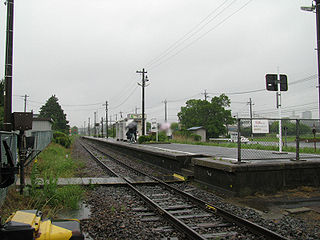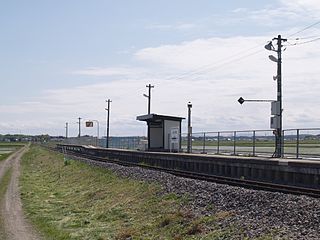
The Tōhoku Main Line is a 575.7-kilometre-long (357.7 mi) railway line in Japan operated by the East Japan Railway Company. The line starts from Tokyo Station in Chiyoda, Tokyo and passes through such cities as Saitama, Utsunomiya, Fukushima, and Sendai, before reaching the end of the line in Morioka. The line originally extended to Aomori, but was truncated upon the extension of the Tōhoku Shinkansen beyond Morioka, which mostly parallels the Tōhoku Main Line. A portion of the Tōhoku Main Line is also shared with the Keihin–Tōhoku Line and the Saikyō Line.

The Jōban Line is a railway line in Japan operated by the East Japan Railway Company. The line officially begins at Nippori Station in Arakawa, Tokyo before the line officially ends at Iwanuma Station in Iwanuma, Miyagi. However, following the opening of the Ueno–Tokyo Line, Jōban Line train services originate at Shinagawa or Ueno; likewise, Jōban Line trains continue past Iwanuma onto the Tōhoku Main Line tracks to Sendai. The line approximately parallels the Pacific coasts of Chiba, Ibaraki, and Fukushima Prefectures.

The Banetsu West Line is a railway line in Japan operated by East Japan Railway Company. It connects Kōriyama Station in Kōriyama, Fukushima Prefecture, and Niitsu Station in Akiha Ward, Niigata, Niigata Prefecture. The name "Banetsu" is taken from the first characters of the names of the ancient provinces of Iwaki (磐城) and Echigo (越後), which the Banetsu East and Banetsu West lines connect. "Sai" (西) means "west" in Japanese.

The Takayama Main Line is a Japanese railway line between Gifu Station in Gifu and Toyama Station in Toyama, operated by Central Japan Railway Company and West Japan Railway Company. The line directly links the Chūkyō Metropolitan Area and Hokuriku region in a shorter distance, but with a longer travel time, than by using the combination of the Tōkaidō Shinkansen and Hokuriku Main Line. Now the line primarily functions as a way to access the scenic areas of Hida, in the rugged mountains of northern Gifu Prefecture, such as Gero onsen, Takayama, Shirakawa-gō, and the Kiso River. The first section of the line, between Gifu and Kagamigahara, opened in 1920. The whole line was completed in 1934.

The KiHa E130 series (キハE130系) is a class of diesel multiple unit (DMU) trains operated since January 2007 by the East Japan Railway Company in Japan.

The KiHa 100 and 110 series (キハ100・110系) are diesel multiple unit (DMU) trains operated since 1990 by East Japan Railway Company on non-electrified rural lines in Japan.

The Ban'etsu East Line is a railway line in Fukushima Prefecture, Japan operated by East Japan Railway Company. It connects Iwaki Station in Iwaki and Kōriyama Station in Kōriyama. The name "Ban'etsu" is taken from the first characters of the names of the ancient provinces of Iwaki (磐城) and Echigo (越後), which the Ban'etsu East and Ban'etsu West lines connect. "Tō" (東) means "east" in Japanese.

Asaka-Nagamori Station is a junction railway station in the city of Kōriyama, Fukushima Prefecture, Japan operated by East Japan Railway Company.

Hitachi-Aoyagi Station is a passenger railway station in the city of Hitachinaka, Ibaraki, Japan operated by East Japan Railway Company.

Shimo-Sugaya Station is a passenger railway station in the city of Naka, Ibaraki, Japan operated by East Japan Railway Company.

Kami-Sugaya Station is a junction passenger railway station in the city of Naka, Ibaraki, Japan operated by East Japan Railway Company.

Saigane Station is a passenger railway station in the town of Daigo, Kuji, Ibaraki, Japan, operated by East Japan Railway Company.

Higashidate Station is a railway station in the town of Yamatsuri, Fukushima, Japan operated by East Japan Railway Company.

Iwaki-Tanakura Station is a railway station in the town of Tanagura, Fukushima, Japan operated by East Japan Railway Company.

Minami-Sakaide Station is a passenger railway station in the city of Naka, Ibaraki Prefecture, operated by East Japan Railway Company.

Nukada Station is a passenger railway station in the city of Naka, Ibaraki, Japan operated by East Japan Railway Company.

Kawai Station is a passenger railway station in the city of Hitachiōta, Ibaraki Prefecture, operated by East Japan Railway Company.

Yagawara Station is a passenger railway station in the city of Hitachiōta, Ibaraki Prefecture, operated by East Japan Railway Company.

Hitachi-Ōta Station is a passenger railway station in the city of Hitachiōta, Ibaraki Prefecture, operated by East Japan Railway Company.

The Tokiwa (ときわ) is a limited express service operated by East Japan Railway Company between Shinagawa in Tokyo and Iwaki via the Joban Line and Ueno-Tokyo Line since 14 March 2015. The services replaced the former Fresh Hitachi services operated on the Joban Line between Ueno and Iwaki. The Tokiwa train service name was also formerly used for semi-express services operated by Japanese National Railways (JNR) from June 1958 until March 1985.






















